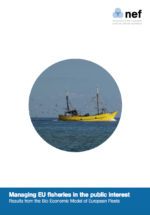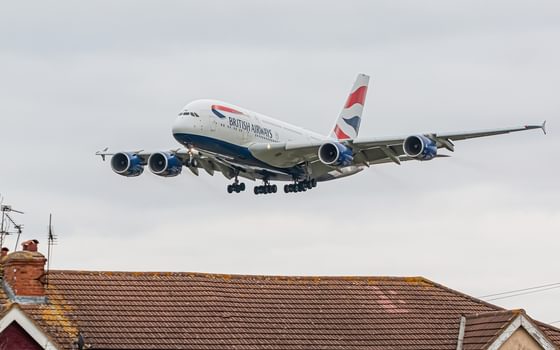Managing EU fisheries in the public interest
Results from the Bio-Economic Model of European Fleets
13 March 2015
For too long, overfishing has cost Europe millions in lost landings, profits and jobs. Quotas and subsidies have been allocated to fleets regardless of their economic, social or environmental performance. The reformed Common Fisheries Policy, in force since 2014, is an opportunity for change. But change will not happen without action from member states.
Letting fish stocks grow to the point where they are most productive in perpetuity – their ‘maximum sustainable yield’ (MSY) – demands a reduction of fishing pressure for a set period of time. Reallocating quotas mean less fish for fleets that have traditionally received more access to the resource. While society would largely benefit, trade-offs must be made. European ministers must not shy away from making tough decisions that safeguard our fish stocks.
To date, attention has mostly focused on the short-term costs of transitioning to MSY. The long-term benefits of reaching MSY and the potential economic impacts of reallocating quotas have largely been ignored.
To understand the possible benefits and trade-offs involved in reallocating quotas and rebuilding fish stocks, the New Economics Foundation (NEF) analysed more than 221 EU fleets covering 73% of EU landings. We used the largest official dataset for the EU fleet, the Annual Economic Report (AER).
Our research shows that sustainable fisheries management and the reallocation of quotas – according to four alternative criteria (‘job creation’, ‘fuel use’, ‘profit’ and ‘effort’) – would increase revenues and create jobs more effectively than the current allocation based on historic share.
Reallocating fishing quotas to lower-carbon fleets would deliver an additional 14,584 jobs and save 624,000 tonnes of carbon per year, but profitability and wages would fall. Increasing quota to fleets that support more jobs per tonne of fish landed would create 102,000 jobs, but increase carbon emissions.
It is not realistic to fully allocate quotas according to a single criterion, but it is possible allocate shares of the quota. The current quota system is highly concentrated, so small allocations of 5% to 10% could bring huge economic benefits.
This new data was produced using the Bio-Economic Model of European fleets (BEMEF), which NEF has developed over the past two years with help from academics and institutions across the EU. BEMEF is the first model to estimate the economic impacts of reallocating fish quotas across fleets under alternative allocation criteria.
BEMEF also looks at how rebuilding fish stocks beyond MSY would affect landings, revenues, employment, profitability, wages and carbon emissions. We found that keeping our fish stocks below MSY in the last five years caused a total loss of 8.6 million tonnes of catch and €7.1 billion in revenues. Rebuilding most commercial EU fish stocks in North Atlantic waters to their MSY would deliver:
- 2,052,639 tonnes of additional fish per year, enough to meet the annual demand of 89.2 million EU citizens
- €1,565 million additional gross revenues per year
- €824 million additional net profits per year
- between 20,362 and 64,092 new jobs
- €8,273 in additional fishing wages each year.
All these benefits would accrue directly to the EU. The results are conservative because our analysis does not incorporate other fishing areas (i.e. Mediterranean) or non-commercial species.
As in all economic impact studies, these results depend on the assumptions underlying the model and the outcomes that we want to prioritise. For example, while it is possible to simultaneously deliver more profits, more jobs and higher wages at MSY, further jobs could come at the expense of wages and profits and vice-versa.
By making the data, results and assumptions accessible, we hope those involved in EU fisheries management – from fishers to ministers – can have a more honest conversation about the impacts and trade-offs involved in rebuilding fish stocks beyond MSY and reallocating quota.
EU member states can secure these benefits simply by implementing the reformed Common Fisheries Policy (CFP)1 which came into force in January 2014. The CFP requires fishing limits for all stocks to be sustainable by 2015 where possible and by 2020 at the latest (Art 2.2). It also requires member states to take social and environmental criteria into account when allocating fishing opportunities such as quota (Art 17).
Member states must do more to translate this potential into reality. The state of some fish stocks has improved. However, in December 2014 EU fisheries ministers set limits for 2015 above scientific recommendations for 63% of stocks. Few member states, if any, are looking seriously at alternative quota allocation.
To secure the best economic, social and environmental outcomes for their citizens, member states must focus their attention on:
- ensuring fishing opportunities and ‘total allowable catches’ do not exceed scientific advice
- reviewing how they allocate quotas across the fleet, and implementing pilot schemes to test new allocation criteria
Even though it is still at an early stage, BEMEF can help our policymakers do this.
Image credit: ztephen via Flickr
Topics Environment Fisheries & farming







